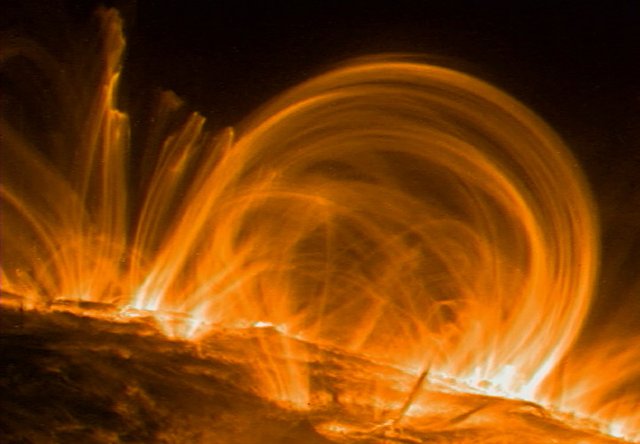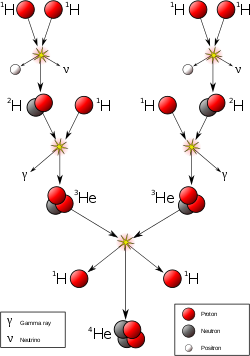(Advanced) How the Sun Works Part 1: It Begins in the Core

TRACE/NASA
Why is it that every morning a ball so bright it can't be stared at arises into the sky?
The answer of course is because the Earth rotates around and axis and therefore certain sides will face towards and away from the Sun lying in the center of our solar system. But of course you already knew that, the real question is why does that sun continually shine, why is it always up there. the same size, the same brightness, where does the energy come from? That is what I'll be discussing in this article and likely a couple follow-ups, but just so you know ahead of time, this article will be written on a slightly more advanced level than most of my others, so you may need to sit down.
Let us begin with a bit of history, the Sun has been a prominent object in the sky for as long as life has been around. But theories as to what it is and why it shines have always been changing. In ancient times, it was almost certainly thought to be a large ball of fire, there's little record of such times, however one can logically conclude that there's nothing else hunter-gatherer era humans would make of such an object.
Fast forward to the ages of semi-recorded history and slightly more complex theories arise, the Greeks believed it to be the Sun god Helios riding his chariot across the sky, and the ancient Egyptians believed the first rising of the Sun was the beginning of life on Earth.
However intriguing, these explanations only seem to cover what the Sun is for and what created it, what they don't seem to tackle is how it works. The first major idea for this, likely prevalent from around the late 17th century until the mid 19th century, was that the Sun was a large ball of Coal. Not a bad thought given the idea that coal burns with short range flares, and thus, on a large scale, would look fairly consistent across the surface. Come later times, we were just beginning to understand the Earth's interior and find how Gravity could compress large scale objects and generate friction, hence why the Earth had a hot interior, (Although most of Earth's geothermal energy comes from radioactive decay). This led to the idea that the Sun was in fact a large ball of Earth-like matter simply collapsing under its own Gravity, heating itself through compression.
This would remain the most prominent idea for a while, but it all changed in 1905 when the most important equation in the history of Physics was discovered by the most important physicist; Albert Einsteins E=mc^2
This tiny equation was the missing link to understanding Stars and how the Universe gets most of its power. It effectively describes how mass and energy can be converted into one another in a multitude of methods. One of which is Nuclear reactions.
Note the title, a nuclear reaction involves the direct changing of an atoms core, the nucleus comprised of protons and neutrons. These are far different from chemical reactions, which don't have any effect on the nucleus but only with the electrons. One type of reaction is known as Fission, where an atom splits into several more atoms, we use this for our nuclear power plants.
But the efficiency of fission is far surpassed by that of fusion. Depending on the reaction, the fusion of atom an convert as much as 1% of the total mass in the reactants into energy, which is a LOT of energy. A typical campfire using Oxygen chemical reactions is only operating at an efficiency of 0.0000000014% mass to energy conversion because it deals exclusively with electrons, which have a tiny fraction of the mass of protons and neutrons.
So the Sun fuses elements, but how it does so and what results from the process is far more complex that simply saying, "Hydrogen fuses into Helium".
Enter the Proton-Proton Chain Reaction, or P-P chain for short. Understanding this process is crucial to understanding the basics of Nuclear fusion.

There are a few ways for this reaction to play out, ultimately they accomplish something very similar in the end. But to start, you need Hydrogen, and not just any Hydrogen, you need single Hydrogen protons. This is what a star is almost entirely made of when it is born, Hydrogen atoms comprised of one protons and one electron with no neutrons dominate the initial composition. However, under the immense heat that occurs with the formation of a star, Hydrogen gets ionized into plasma, a forth state of matter where the atoms have so much kinetic energy that the electrons are free to fly all over the place and pair with protons and shortly after leave constantly. A reacting proton will grab an electron out from the free space when it undergoes fusion, and you'll see that this is very important soon.
Once the core of a forming star reaches about 4 Million K, fusion can begin, However our star's core reaches well into the range of 15 Million K. At these temperatures, atoms are vibrating so fast that they become relatively easy to fuse, of course you also need pressure pushing the atoms to occupy less space along with the heat. Thankfully our sun has about 300,000 times to mass of Earth, 2,000,000,000,000,000,000,000,000,000 Tons. As you can imagine, the gravity of such an object can put down a pretty good amount of pressure, enough in fact, to fuse atoms.
In the core of the Sun the pressure goes through the roof, 250 Billion times Earth's atmospheric pressure, the matter within this region is compressed to 150 grams per cubic centimeter, 19 times the density of Iron at room temperature on Earth.
When two atoms, one proton and one electron, come together, almost every time they will create what is called a Diproton, this is a highly unstable form of Helium, with two protons and two electrons, but no neutrons. The two protons will repel each other from electric charge and split back into the original atoms almost instantly. Producing no energy in the process.
But remember, I said "Almost" every time, once out of every dectillion or so times the fusing atoms will become something different.
The discrepancy is caused by the the Nuclear forces, I'll spare you the intricacies of quantum mechanics but the strong and weak nuclear forces have ranges of influence, the weak force's range is very short and thus only takes effect over the strong force on rare occasions, but when it does something incredible happens, a proton turns into a neutron.
This is critical, because the newly created atom now has a different structure to that of the diproton, it is now the perfectly stable Hydrogen known as deuterium. Remember that an atom is based on the number of protons, no the total number of hadrons in the nucleus. So when one atom's proton turns into a neutron, the final atoms is now also Hydrogen, but more stable as it has a neutron.
There are also by products to this reaction. Remember that the former proton has lost it's charge, that charge is carried away in the form of a positron. A positively charged electron, also known as antimatter. It will almost immediately collide with a free-floating electron after being made, and what happens when anti-matter and normal matter collide?

Image credit to US gov
Except much smaller than this, a single positron and a single electron will result in completely annihilate each other, but they have only a tiny amount of mass. Even still, positron-electron collisions do make up at least some of the total energy output of the Sun.
Along with the positron, remember that each of the involved reactants had an electron to start, but the final result only has one proton, so one of those electrons has got to go. And it does so in a strange way, it becomes a neutrino.
We would refer to this specific neutrino as an electron neutrino given its origin, it carries away some energy and unlike the positron, it make it all the way out, in fact it will likely do so in only a few seconds. Neutrinos travel at the speed of light and have no measurable mass. They also are very stubborn with giving up their energy and very rarely interact with normal matter. They can, but most often they will simply pass right through the entire Sun and be on their way. Just to give you an idea of how many there are, every single second you are hit with about 4 trillion neutrinos depending on your angle to the Sun. And that's just you, from 156 million kilometers away.
Apart from those two things, no energy is created in this part of the cycle, but as the diagram shows, more is yet to happen.
The next portion of the cycle involves taking the newly made deuterium and colliding it with a free floating Hydrogen 1 atom. This part is a major source of energy for the branch, this is where a Gamma ray is directly produced by a nuclear reaction. Along with that, a new element is also now in place, a stable Helium atom has been created. Two protons and one neutron.
After this, we need two of these stable Helium atoms together, get them nice and close and they will smash into one another and give birth to a larger Helium atom with two neutrons, along with sending off two Hydrogen 1 atoms to go back into the cycle. And once again, a Gamma ray is sent flying away.
And there you have it, the first and foremost part of the Sun's energy conversion, branch 1 of the P-P chain. Roughly speaking, about 90% of the Sun's energy is created somewhere in this cycle, most by the fusion of Deuterium and H1, along with the fusion of two Helium 3 atoms. And just a little bit from the initial fusion of two H1's.
But wait, 90%, where's the rest of it coming from? Well originally I was going to go on from here, but this article is getting pretty long, so I'll stop here and continue later on, talking about the other branches of the P-P chain and the interior workings of the Sun. Eventually leading to the outer layers and Magnetic fields.
Until then.
Wow what an amazing read! It's easy to forget about all that happens out there. But sometimes you gotta stop, look up, and blind yourself a little, and you'll begin to wonder what the sun is and how it all works. And why it's so bright too.
Can't wait to read part 2! I'll follow you so I don't miss it!
Thank you for your contribution. Dont forget to link references and sources when applicable!
=======================================================================================
This post was upvoted and resteemed by @Steemgridcoin with the aim of promoting discussions surrounding Gridcoin and science.
This service is free. Please follow @steemgridcoin if you want to support this initiative.
Have a nice day. :)
Congratulations! Your post has been selected as a daily Steemit truffle! It is listed on rank 25 of all contributions awarded today. You can find the TOP DAILY TRUFFLE PICKS HERE.
I upvoted your contribution because to my mind your post is at least 4 SBD worth and should receive 112 votes. It's now up to the lovely Steemit community to make this come true.
I am
TrufflePig, an Artificial Intelligence Bot that helps minnows and content curators using Machine Learning. If you are curious how I select content, you can find an explanation here!Have a nice day and sincerely yours,

TrufflePig